Janet Cardiff – The Forty Part Motet
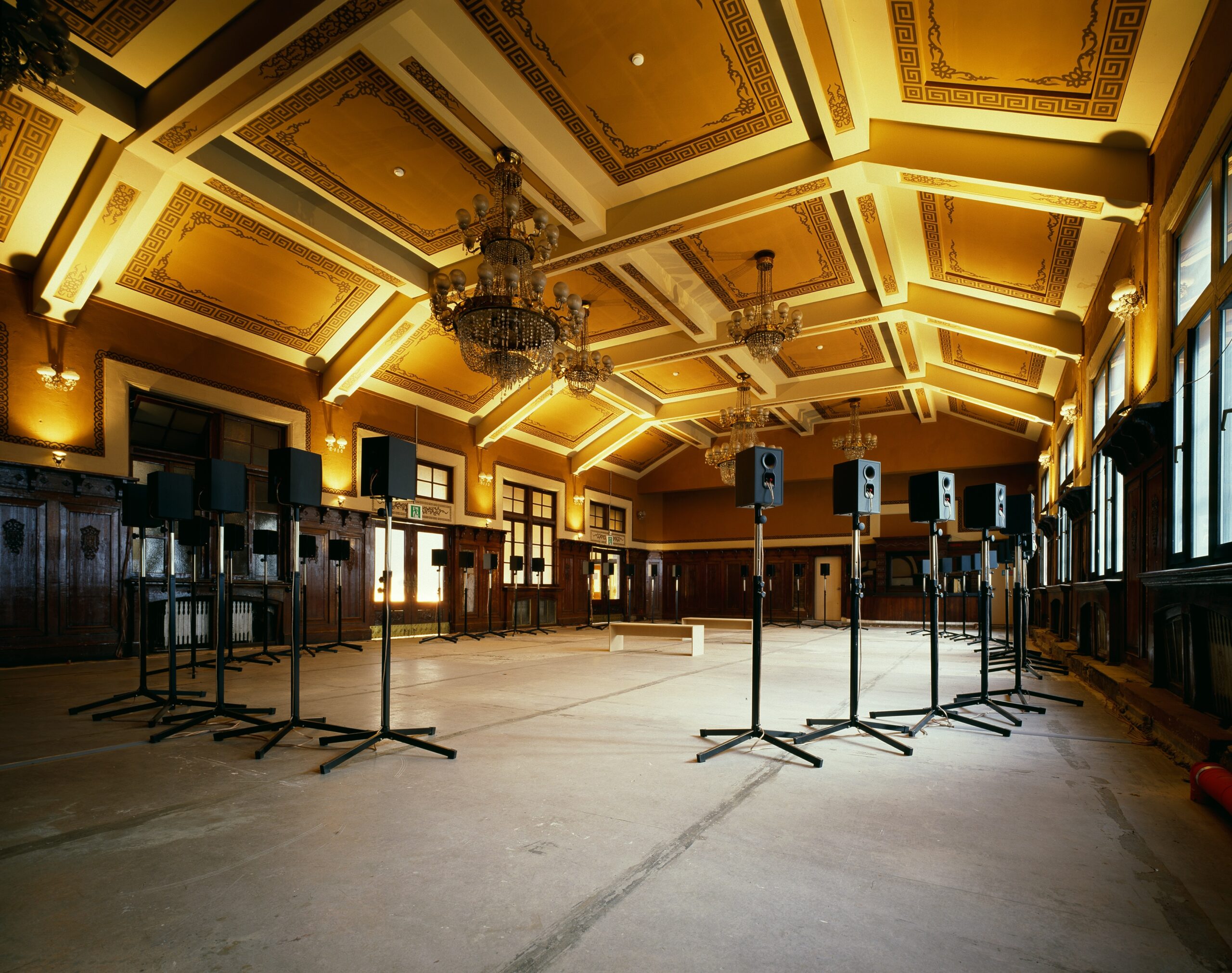
Exhibition
- Dates
- Fri., Oct. 17 - Sun., Nov. 16, 2025
- Hours
- 10:00 - 20:00 (last entry 19:30)
- Closed
- Oct. 27, Nov. 10
- Venue
- Temporary Exhibition Gallery
A Groundbreaking Realm of Sound That Enchanted the World Arrives in Nagasaki
The Nagasaki Prefectural Art Museum is pleased to present an exhibition of The Forty Part Motet, a sound installation by Canadian artist Janet Cardiff.
This work is based on Spem in alium (commonly known as the Forty Part Motet), a Renaissance choral composition by English composer Thomas Tallis. In Cardiff’s immersive 14-minute installation, 40 individual voice parts are played through 40 speakers arranged in an oval, with visitors able to move freely among them. Visitors “enter” the music, walking through the space and hearing many layers of sound that shift depending on their position. The installation brings them into close contact with the voices of individual singers while powerfully conveying the way in which sound physically constructs space. When all the voices converge, visitors experience the overwhelming sensation of being enveloped in a wave of sound.
Since its debut in 2001, Cardiff’s The Forty Part Motet has been exhibited around the world. In Japan, it was shown in 2009 (Ginza Maison Hermès Le Forum), 2010 (Suntory Museum, Tempozan), and 2013 (Aichi Triennale 2013, Aichi Prefectural Museum of Art), leaving audiences with a strong and enduring impression. After more than a decade without being shown in Japan, the work will once again be exhibited as it tours four museums from March of this year through February of next year: Hara Museum ARC (Shibukawa City, Gunma Prefecture); the 21st Century Museum of Contemporary Art, Kanazawa; the Nagasaki Prefectural Art Museum; and the Marugame Genichiro-Inokuma Museum of Contemporary Art. This tour makes it possible for audiences in Nagasaki to experience this widely celebrated work.
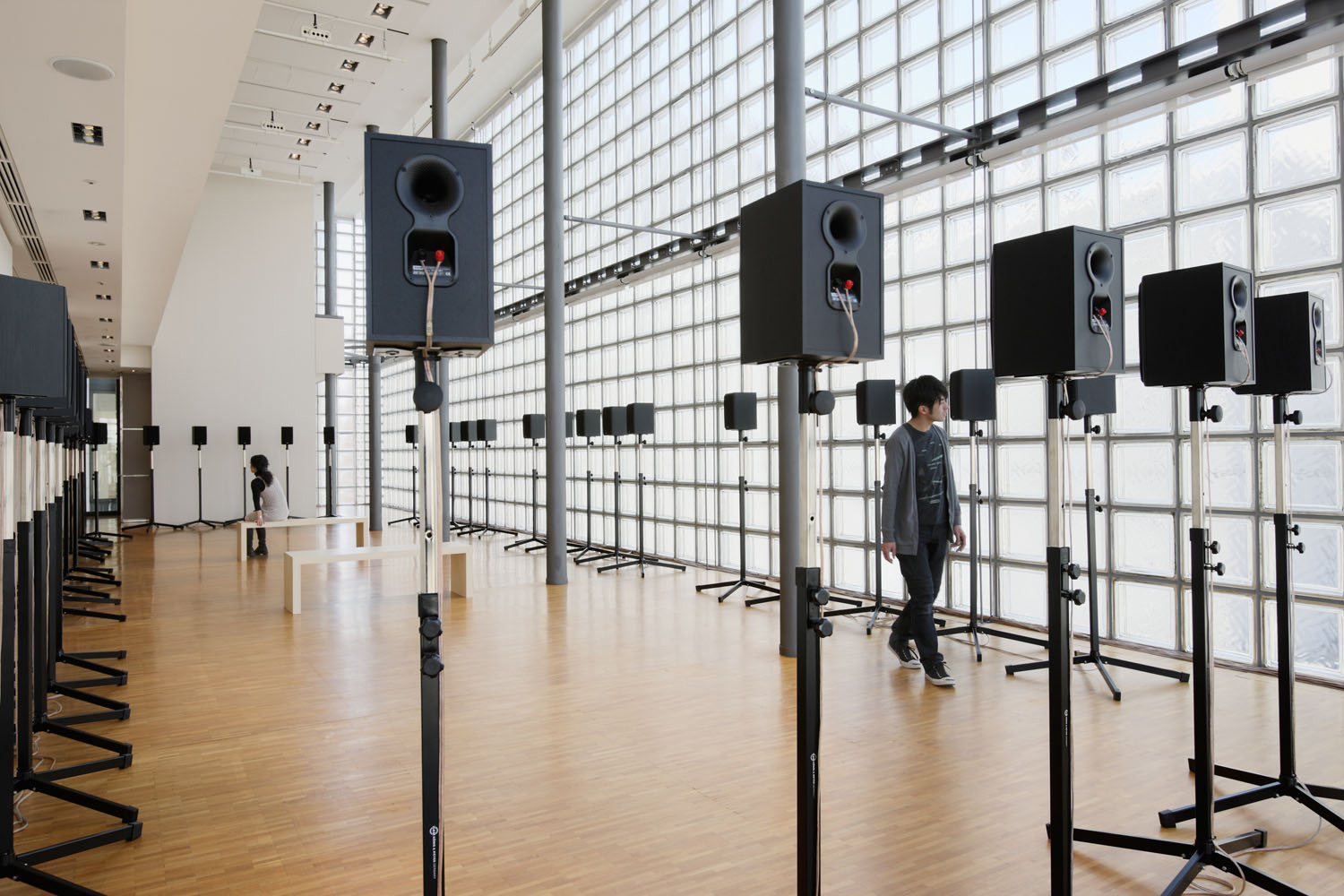
Photo by Atsushi Nakamichi / Nacása & Partners Inc. Courtesy of the Fondation d’entreprise Hermès, 2009
This museum, which celebrated its 20th anniversary in April 2025, has actively provided opportunities for appreciation of music as well as visual art to the local community since its opening. For example, the Evening Live concert series, a collaborative project with Nagasaki University and Kwassui Women’s University, has presented more than 400 concerts in total. Exhibiting this work, a sound installation that unites visual art and music, in our 20th anniversary year serves as a symbolic expression of the initiatives our museum has undertaken.
The exhibition will present this single work, installed in half of the special exhibition gallery. The gallery, with a ceiling height of 5.8 meters, has large north-facing windows that are usually covered with screens. For this presentation, they will be opened onto views of Nagasaki Harbor and the scenery across the water. In this environment, visitors are invited to immerse themselves in this masterpiece of sound installation.
Sensory Notice
The 40 Part Motet is a large-scale sound installation using choral music that sounds for eleven minutes with three minutes of intermission, played in a loop. This loud sound may be overwhelming to those with sensory sensitivities. Also, natural light enters the gallery through the large north-facing window, creating a bright environment during the day.
Please speak with a museum staff member if you have any questions.
Noise-cancelling earmuffs are available for those with sensory sensitivities.
Please ask at the reception desk on the second floor to borrow a pair.
Artist profile
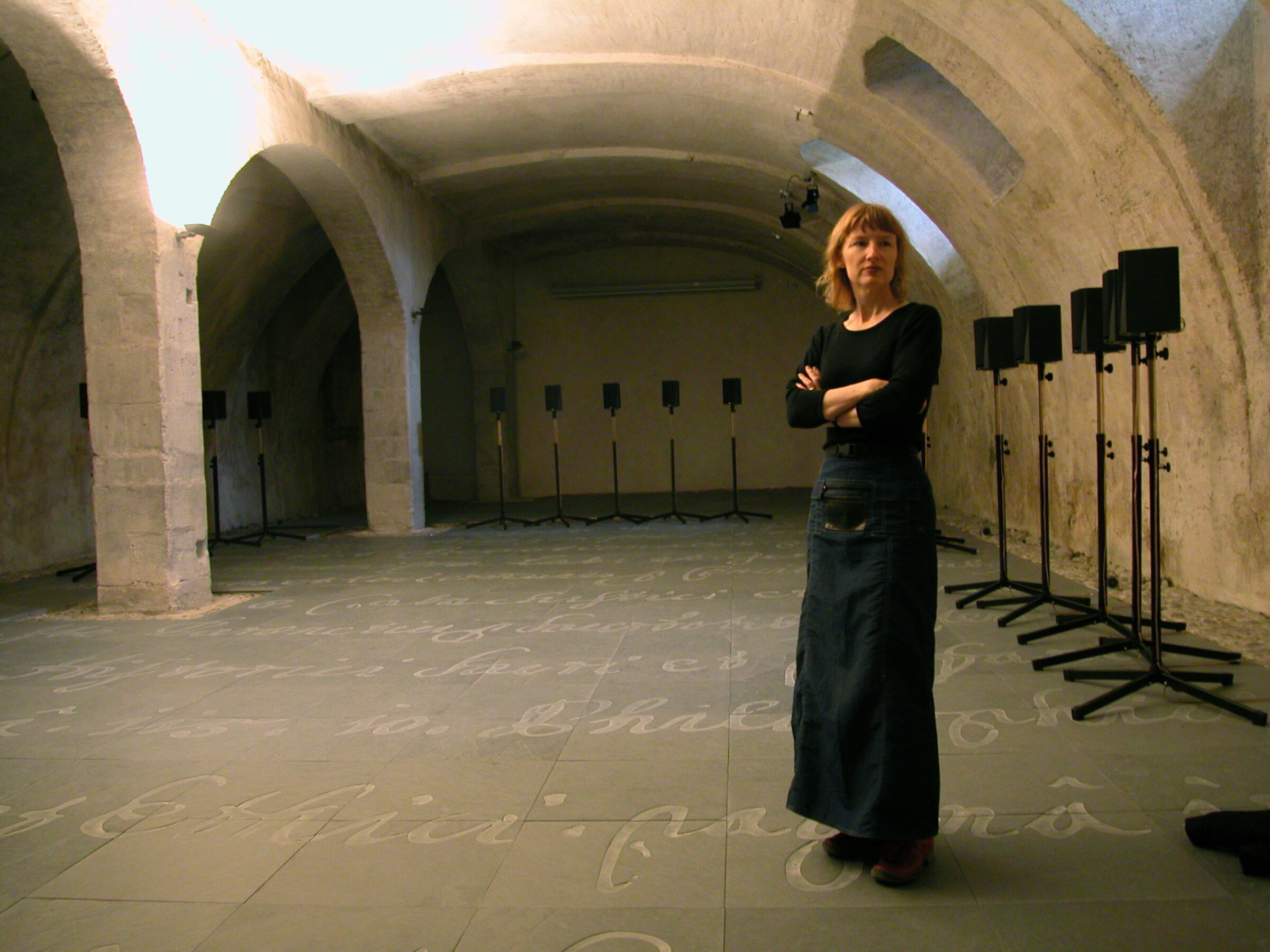
Photo by Stephan Rohner. Courtesy of the artist and Luhring Augustine, New York / Fraenkel Gallery, San Francisco / Gallery Koyanagi, Tokyo.
Janet Cardiff (b.1957-) is a Canadian artist based in rural British Columbia. She participated in the Skulptur Projekte Münster in 1997, exhibiting in the Carnegie International in Pittsburgh, 1999. She also represented Canada at the Venice Biennale in 2001 in collaboration with George Bures Miller. Since then, the duo has continued to create groundbreaking installations that harness the full potential of audio and media technologies, earning international renown. Their immersive works, which vividly engage both eyes and ears and elicit profound emotional responses, have also found a strong following in Japan, where a solo exhibition was held in 2017 at the 21st Century Museum of Contemporary Art, Kanazawa. Their installation Storm House enjoyed great popularity at Benesse Art Site Naoshima (2010-2021). The National Museum of Art, Osaka holds a site specific audio installation Osaka Symphony (2018) in its collection. In 2023 they opened the Cardiff Miller Art Warehouse (CMAW), a large exhibition space in Enderby, BC to permanently showcase their multimedia works.
Thomas Tallis’s Spem in alium
A motet is a polyphonic religious choral composition that originated in late medieval Europe and developed during the Renaissance. Thomas Tallis’s (c. 1505–1585) Spem in alium, known as the “40 part motet,” is one of the representative works of Renaissance music in England. It is composed of an enormous number of voices—40 parts (5 voices × 8 groups).
Thomas Tallis was the most influential English composer of his generation and is one of the most popular renaissance composers of today. He served as an organist to four English monarchs – Henry VIII, Edward VI, Queens Mary and Elizabeth – as a gentleman of the Chapel Royal. One of his greatest works was this composition for forty parts – eight choirs of five voices. There is some debate as to whether the composition was authored in celebration of Queen Elizabeth I’s or to honour Queen Mary’s 40th birthday.
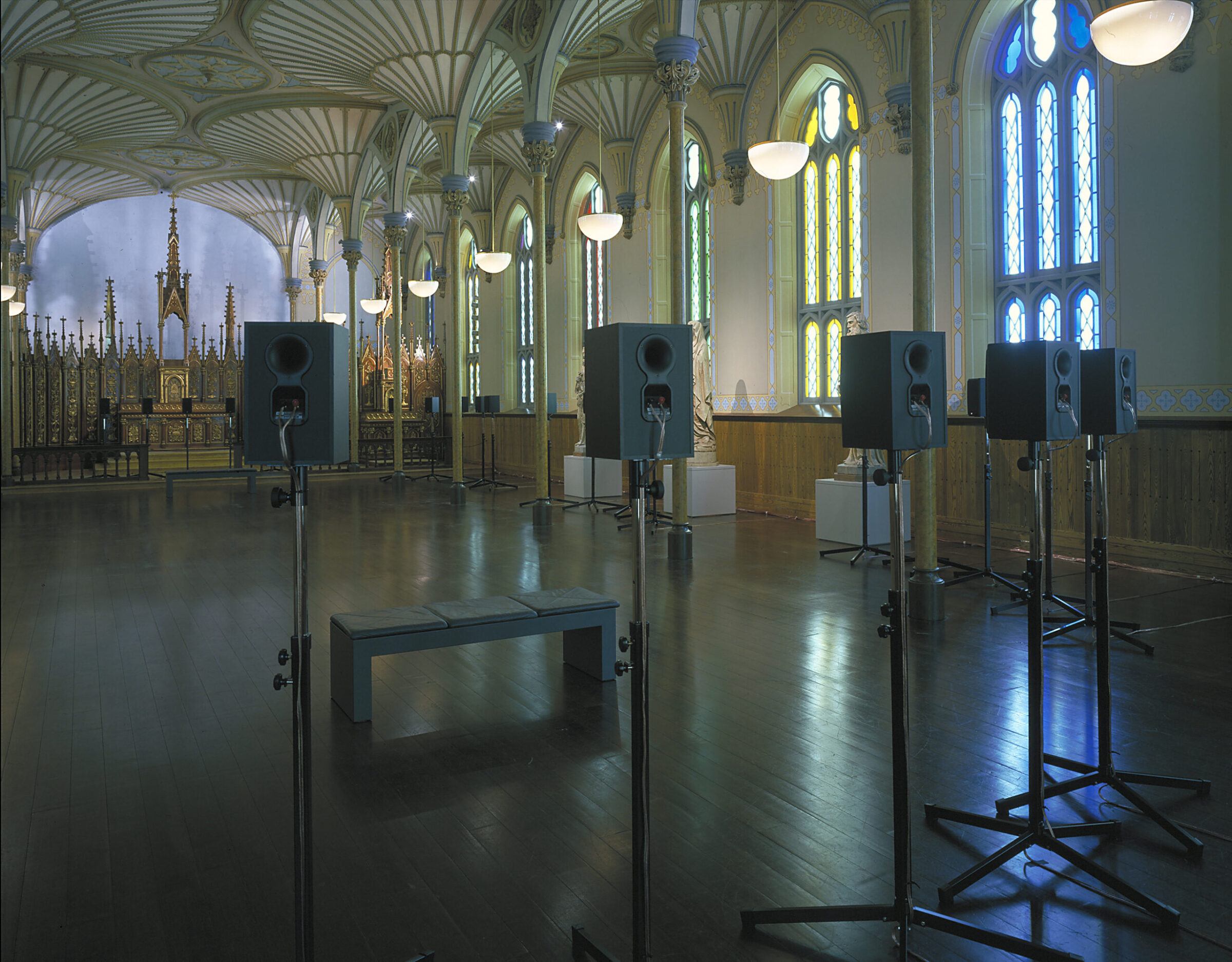
Courtesy of the National Gallery of Canada.
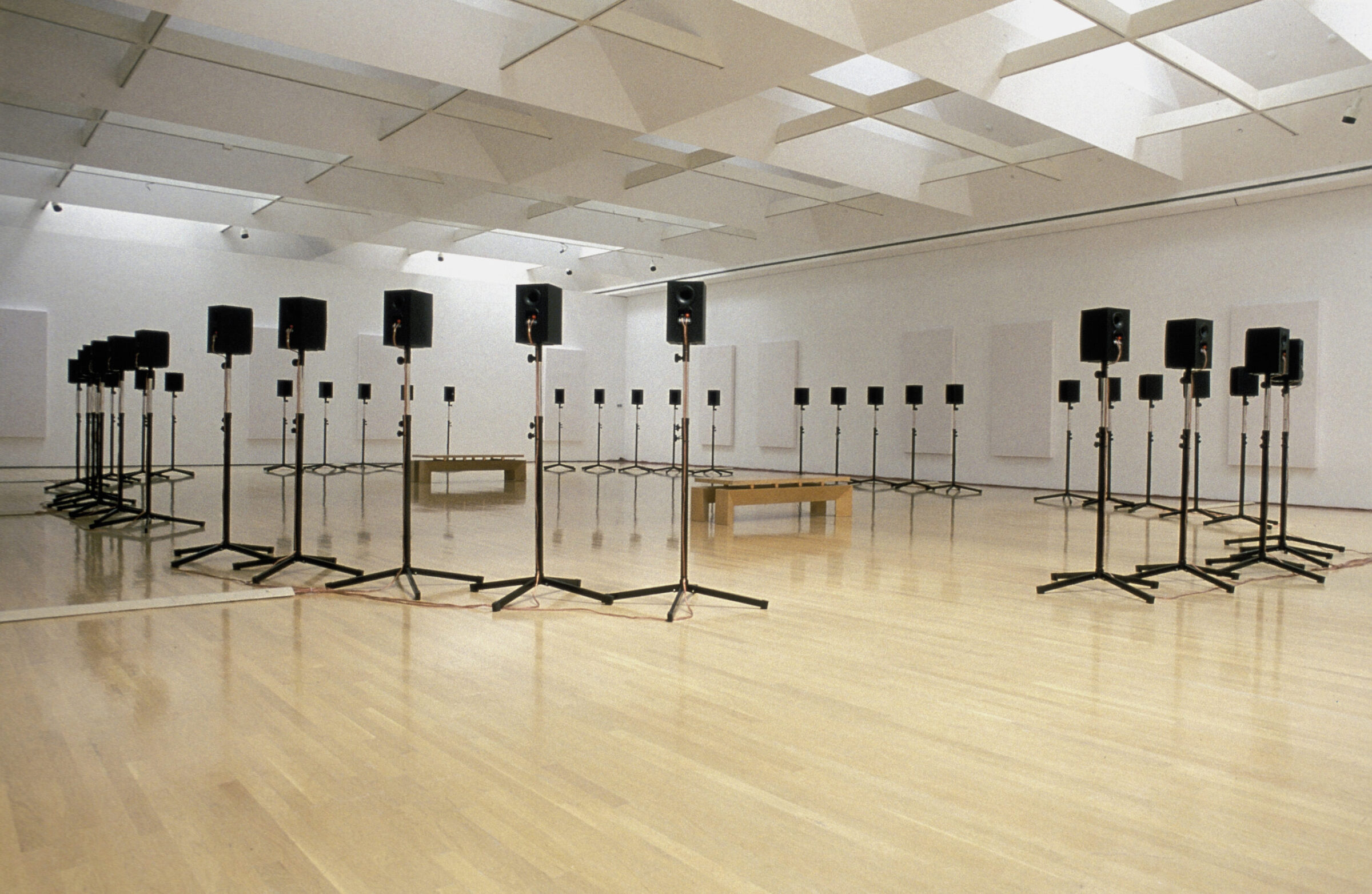
Courtesy of the artist and Luhring Augustine, New York / Fraenkel Gallery, San Francisco / Gallery Koyanagi, Tokyo.
Quotes from the artist
“While listening to a concert you are normally seated in front of the choir, in traditional audience position. With this piece I want the audience to be able to experience a piece of music from the viewpoint of the singers. Every performer hears a unique mix of the piece of music. Enabling the audience to move throughout the space allows them to be intimately connected with the voices. It also reveals the piece of music as a changing construct. As well I am interested in how sound may physically construct a space in a sculptural way and how a viewer may choose a path through this physical yet virtual space.”
“I placed the speakers around the room in an oval so that the listener would be able to really feel the sculptural construction of the piece by Tallis. You can hear the sound move from one choir to another, jumping back and forth, echoing each other and then experience the overwhelming feeling as the sound waves hit you when all of the singers are singing.”
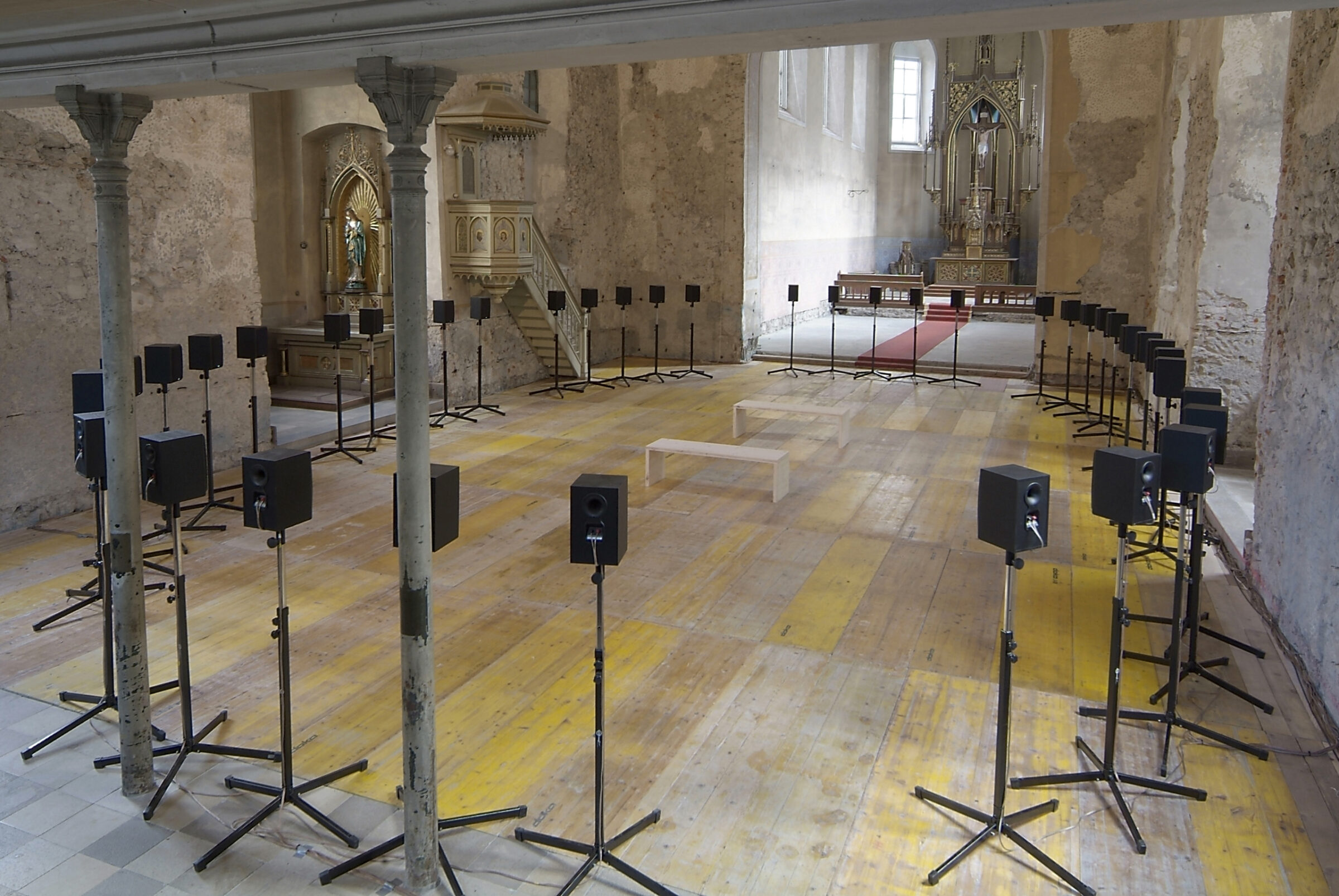
Photo by Markus Tretter. Courtesy of the artist and Luhring Augustine, New York / Fraenkel Gallery, San Francisco / Gallery Koyanagi, Tokyo.
Background on the Recording of the Forty Part Motet
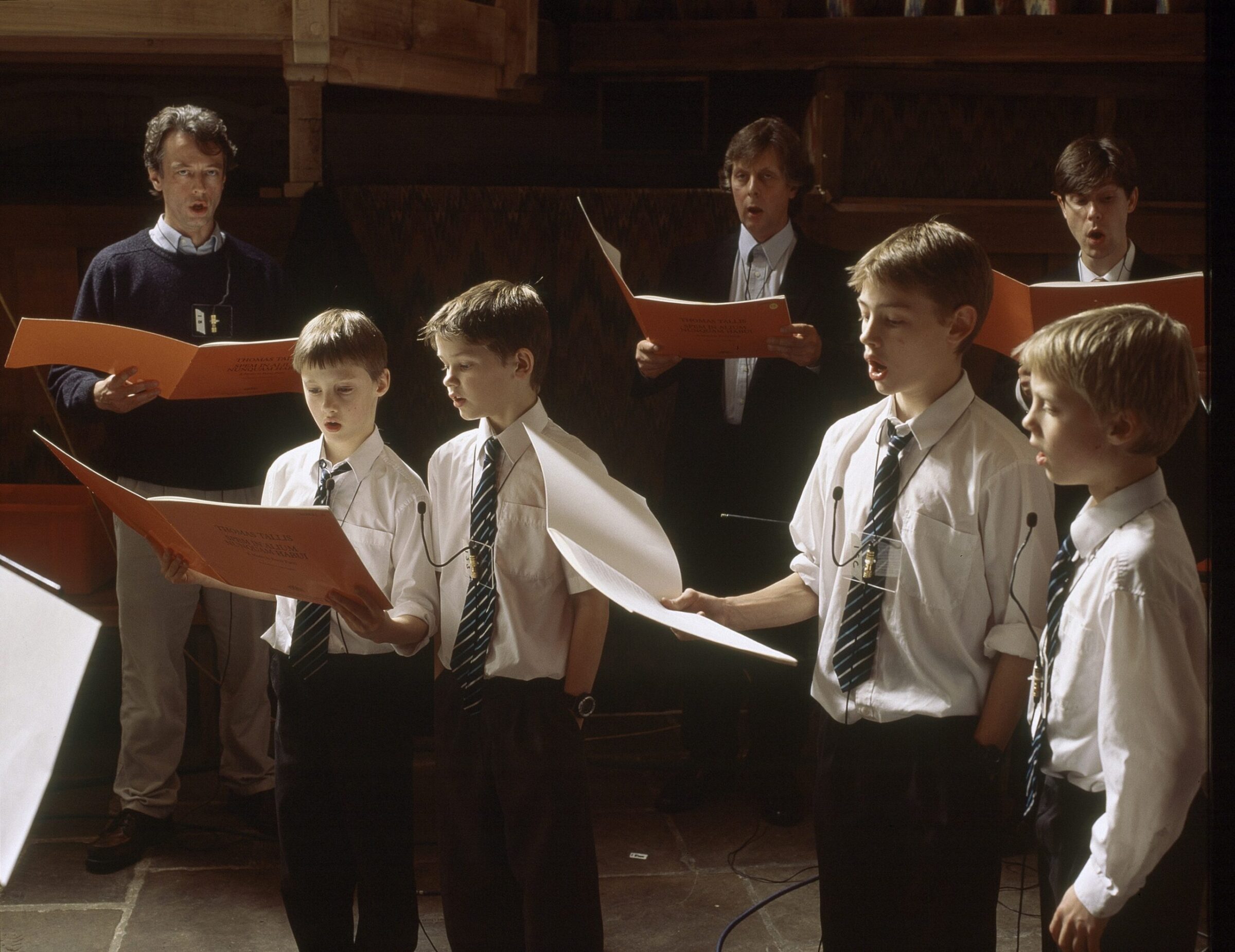
Photo by Hugo Glendinning. Courtesy of the artist and Luhring Augustine, New York / Fraenkel Gallery, San Francisco / Gallery Koyanagi, Tokyo.
In 1998 Janet Cardiff was given a CD of Thomas Tallis’s great forty-part motet Spem in alium. She was enthralled listening to it on a simple stereo system but was also frustrated at not being able to hear each part of the forty-part harmony separately. At the time, Cardiff envisioned creating a sound installation of Spem in alium using forty loudspeakers; the listeners would play an active part in the mixing and blending of voices according to where they chose to stand, to listen, and to navigate the space. When Theresa Bergne (Field Art Projects) invited her to participate in the Salisbury Festival in 2000, Cardiff suggested the idea of the piece as a sound sculpture in a large venue. After a year of research and organization, they were able to create the work, recording Spem in alium as part of the festival with singers from the Salisbury Cathedral Choir and elsewhere in England.
The sound installation involved a complex recording process. Written for forty parts—or distinct musical lines—the motet is divided into eight choirs of five parts each (soprano, alto, tenor, baritone, and bass). Since Cardiff preferred the versions of the piece that use children’s, rather than women’s, voices for the soprano parts, twenty-seven boys and girls joined the thirty-two adult male choristers to provide the soprano voices.
The recording took place in a hall on the grounds of the cathedral that was lined with blankets and curtains to create an acoustically “dead” sounding environment. During the recording session, the adult singers stood about five feet apart from one another in order to keep their voices separate, but the children were grouped together to sing the soprano parts of the composition. Each of the fifty-nine singers wore an individual high-quality lavaliere microphone with a special mount to ensure that the microphone was right in front of him or her. All fifty-nine cables were run from the singers to a mobile truck outside—in effect, the recording studio—where fifty-nine tracks were laid and then (mixing the sopranos together) reduced to forty. When the singers took a break during the three-hour session, Cardiff and the editor, George Bures Miller, had decided to keep recording; the singers talking and other sounds can be heard as a three-minute interlude in the final mix, creating an intimate, direct connection between the singers and the listeners. It was necessary to edit out each singer’s track when they were not singing so that the “cross talk” of the other singers would not interfere with the spatial quality of the final presentation.
Data of the artwork
Janet Cardiff, The Forty Part Motet (A reworking of “Spem in Alium,” by Thomas Tallis 1556/1573), 2001.
Audio installation with 40 speakers, stands, and computer.
14 min, loop with 11min. of music and 3min. of conversation.
———————————
Forty Part Motet by Janet Cardiff was originally produced by Field Art Projects with the Arts Council of England, Canada House, the Salisbury Festival and Salisbury Cathedral Choir, BALTIC Gateshead, The New Art Gallery Walsall, and the NOW Festival Nottingham.
Related Program
Lecture & Gallery Tour(*Available in Japanese only.)
Thomas Tallis’s Spem in alium and Religious Music of the Renaissance
This program offers an introduction to Renaissance religious music and the motet form, deepening understanding of Tallis’s magnum opus Spem in alium from the perspectives of music history and musicology. After the lecture, participants will view the exhibition together with the lecturer.
| Date/Time | Sat., Oct. 18, 2025, 14:00–15:30 (end time approximate) |
| Lecturer | Yuki Mera (Adjunct Instructor, Kwassui Women’s University) |
| Venue | Nagasaki Prefectural Art Museum Lecture Room |
| Capacity | 30 (first-come, first-served; reception opens at 13:30) |
| Admission | Free (exhibition admission ticket required) |
Exhibition information
Admission
| Adults | 1,000 yen (800 yen) |
| Seniors 70+ and university students | 800 yen (600 yen) |
*Children (high school students and under) Free
*Prices in parentheses are for advance tickets and groups of 15 or more people.
*Presentation of the following documents entitles the holder and one caregiver to a 50%
discount: certificate of persons with physical disabilities(身体障害者手帳), care and education certificate for persons with intellectual disabilities(療育手帳), mental health and welfare certificate for persons with psychosocial disabilities(精神障害者保健福祉手帳), claimant’s certificate for welfare services for persons with disabilities(障害福祉サービス受給者証), claimant’s certificate for community consultation support(地域相談支援受給者証), claimant’s certificate for specified disease treatment(特定疾患医療受給者証), claimant’s certificate for designated medical expenses for specified intractable diseases(特定医療費(指定難病)医療受給者証), claimant’s certificate for congenital blood coagulation factor deficiency, etc. medical care(先天性血液凝固因子障害等医療受給者証), claimant’s certificate of medical care for children with chronic specific diseases(小児慢性特定疾病医療受給者証).
*During the exhibition period, admission to the collection exhibition is included with the ticket to this exhibition.
*Same day re-entry is allowed.
Advance Tickets
Sales Period: Sunday, September 14 – Thursday, October 16
Sales Locations: Ticket Pia (P Code 687-317), Lawson Ticket (L Code 81634),Seven Ticket (Seven-Eleven), CN Play Guide (FamilyMart), eplus (eplus.jp), Kobundo Books, Books Kinokuniya Nagasaki Store, Metro Books Nagasaki Main Store, Kusano Bookstore Chitosepia, Nagasaki Prefectural Art Museum
Organizers
| Organizer | Nagasaki Prefectural Art Museum |
| Co-organizer | Nagasaki Culture Telecasting Corporation |
| Special Sponsor | FUJIOKA Holdings |
| Grants from | Nagasaki City Arts and Culture Activities Grant, Nomura Foundation |
| Supported by | Nagasaki Prefecture, Nagasaki City, Nagasaki Prefectural Board of Education, Nagasaki City Board of Education, NAGASAKISHIMBUNSHA, The Nishinippon Shimbun, The Asahi Shimbun, The Mainichi Newspapers, The Yomiuri Shimbun, Nagasaki Cable Media Inc., FM Nagasaki Co.,Ltd. |

